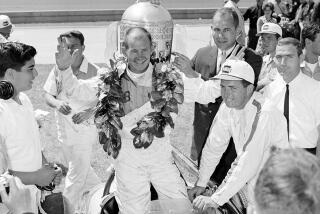Taking Care of Business : Only Real Winners Are Those Who Can Line Up Major Corporate Sponsors
Time was when you would get a gas station, a body shop and maybe an auto parts store together, put their decals on your car and go racing.
If you could get a brewery or a cigarette manufacturer to chip in, you were walking in tall cotton.
Now, it takes a major sponsor’s millions, as many minor sponsors as you can get and even then you have trouble making the NASCAR nut.
Geoff Bodine earned $1,091,762 in Winston Cup purses in 1996. It took him more than $5 million to do it.
“You can’t make it from purse money,” he says. “It can help a lot, particularly if you win. And some purses have gotten pretty big. Texas is awesome and Charlotte is pretty good. But they need to be more.
“And you still need sponsorship to survive. You can’t be in this business without a good sponsor.”
Jeff Burton earned $354,350 for winning the inaugural race at Texas Motor Speedway. Jeff Gordon earned $224,900 for winning at Charlotte, $377,410 for a victory at Daytona.
Burton is just shy of $1 million for 13 races, Gordon is at $1.7. Burton’s Jack Roush team has spent more than $2 million for his success, Gordon’s Hendrick Motorsports more than $3 million.
At the other end of the spectrum, Dave Marcis has earned $264,214. He has spent more than half a million.
“You can’t do it anymore without financial help,” he says. “There’s just no way.”
With that in mind, Corporate America is canvassed for sponsorship dollars, with the promise of exposure to television and appeal to racing fans who support companies that sponsor cars. Team owners and drivers go to marketing executives helmet in hand, armed with statistics that show that people who go to races show a 71% product loyalty, more than any other sport; that 38% of racing fans are women, and not only all that, you can have a little fun too.
Says Rich Peters, who until a week ago ran Penske Motorsports:
“Racing creates the ideal corporate hospitality environment. You can’t take 100 people into a dugout or a dressing room, but you can take them into the pits or garage area.”
So that’s what Corporate America gets for its money. What does the race team get?
Not as much as it used to.
“Racing is extremely competitive and the costs have just skyrocketed,” says Marcis. “The motels gouge you. Team costs on the road. Cost of parts. Everything you do, it seems like it’s tripled the cost or more over the past 10 years.”
A set of four racing tires costs $1,500, and you can use eight sets or more in a race.
A rig to haul the car, parts and tools more than 100,000 miles around the country costs about $120,000, plus fuel, and many teams have two.
The payroll for an average team can run $1,000,000 or more a year, plus benefits, and a car costs about $100,000.
You need 10 or more, because with only a week between races on drastically different courses, you need cars set up for high-banked superspeedways, shorter tracks, road courses, restrictor-plate races at Talladega and Daytona, plus backup cars because wrecks are inevitable.
And you need a show car or two for the public appearances that go hand in hand with sponsorship dollars.
Engines for a season can run $1 million or more, and there is the expense of taking the show on the road. Like most of the teams, Bodine travels with two waves of crew, 10 or more in the first, arriving with the car on Thursday, and 10 or more in the second, ready to work during the race on Sunday.
That means plenty of airline tickets, hotel rooms and restaurant bills.
He estimates that it takes about $5.5 million a year to run a successful operation. Marcis makes do with something less than $2 million, finds little success and would like more money. Richard Childress spends $6 million on each of the cars driven by Dale Earnhardt and Mike Skinner. Rick Hendrick doubtless spends more than that on each of his three drivers--Jeff Gordon, Terry Labonte and Ricky Craven.
Add to that the cost of an airplane, and many teams have them to ferry drivers from appearance to track, and a motor home or two as a base, and the money can skyrocket.
The costs are why Marcis, who can’t afford an airplane or a motor home, is constantly looking for help. And why Bodine, who bought his operation from the estate of the late Alan Kulwicki after Kulwicki died in a plane crash in 1993, is looking to sell all or part of his team.
“We need help,” he says. “We have about 30 people and we’re competing with people like Rusty Wallace, who has 80.
“I’m looking for somebody who has some technical expertise or marketing expertise to buy in.”
Mainly, he’s looking because he wants to keep racing, as he has since 1979, and winning, as he has 16 times.
And he knows the only way to do it is with money.
(BEGIN TEXT OF INFOBOX / INFOGRAPHIC)
The Money Game
A look at the financial side of Geoff Bodine’s racing team:
ANNUAL BREAKDOWN
Payroll: $1,000,000
Tire bill (at $1,500 a set): $500,000
Cars (at $100,000 each): $1,000,000
Engine program: $1,200,000
Travel: $200,000
Miscellaneous: $1,600,000
TOTAL: $5,500,000
More to Read
Go beyond the scoreboard
Get the latest on L.A.'s teams in the daily Sports Report newsletter.
You may occasionally receive promotional content from the Los Angeles Times.










